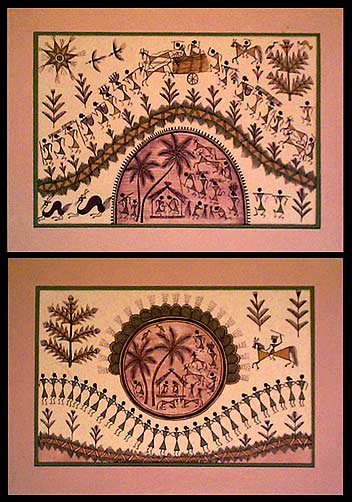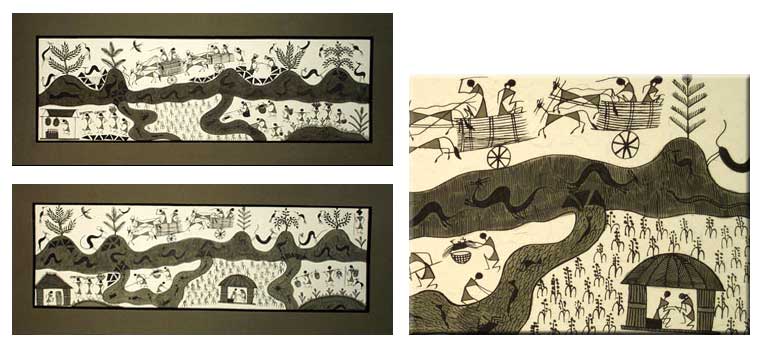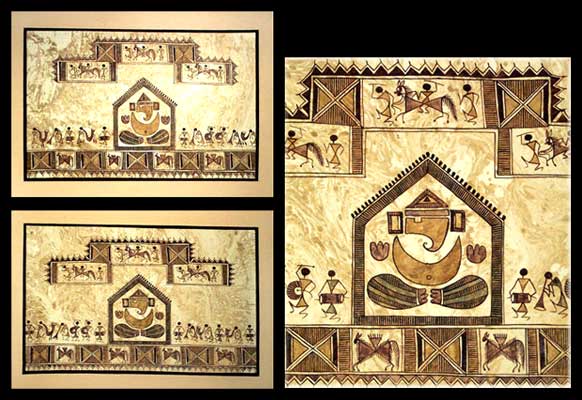

Elephant and rider, Warli style
Source: ebay, Oct. 2006

Updated versions of tribal Warli folk paintings from Maharashtra, by Suman Sonthalia
Source: ebay, Apr. 2002
More examples of Suman Sonthalia's work appear below.
From the website:
 Suman
Sonthalia and Aakriti Arts Creations
Suman
Sonthalia and Aakriti Arts Creations
"Hailing from a conservative Marwari family, I was born in Calcutta on November 5, 1969. For the last ten years I have been engaged in painting Warli-style art, a fine art tradition from rural Maharastra reflective of the daily life of village folks. While cities are stress points of change, villages still retain their original spirit of changelessness that interests me forever. Of course that has rapidly changed the course of this art, making it portable on handmade paper when traditionally it was drawn only on massive clay tablets."Even though I was born in a metropolis, the first fifteen years of my life were spent in a hard-core village of neighboring Bihar, where I had first hand exposure to all aspects of village life. From my childhood, I had a keen interest in drawing and used to sketch the facets of village life in my drawing book. At the conclusion of those fifteen years, I returned to the bustle of Calcutta again but my inspiration had taken too strong a hold to leave me.
"I have lived now in the vicinity of another metropolis - New Delhi - for the last ten years, that is, from the time I was a married. The muse of my formative years refused to leave me and I continued to paint for my own happiness. I come from a conservative Marwari family where girls don't enjoy the freedom of purpose they deserve. But my husband, Mr. B. B. Sonthalia, took deep interest in my art and encouraged me always. Here in New Delhi's Crafts Museum I had the opportunity to see Maharastrian Warli art that was originally executed with wet powder of crushed rice on massive clay tablets. I learnt this art from a national awardee for excellence in handicrafts (without first knowing the person really was that) named Jivya Somamasa. I went to Maharasta to explore into the depths of this art. To my surprise I found it a dying discipline with the new generation not interested in it. The expert artists of this field are sworn drunkards and do work only on commissioned basis. I
have tried to release the art form into newer horizons by painting with natural/vegetable dyes on lightweight handmade paper that can be mounted on the wall. I also use crushed rice to fill the figures in several of my paintings. My paintings are thus highly affordable and are expositions of simplicity in human life and belief."Apart from my very cooperative husband, I have two small children. I can easily manage between eight and ten hours everyday to devote to my art form. Drawing a piece takes nearly four to six hours. It is only for the last three years that I have stepped out as a professional artist. Central Cottage Industries Corporation and Handloom & Handicrafts Promotion Council, Government of India, have helped a lot in establishing me as a professional artist.
Today I have organized several needy girls, who are either orphans or very poor, under the banner of Aakriti Arts Creation. I have taught them this art form and purvey them work to paint on broad designs sketched out by me. I again furbish them with finishing touches and convey them their fair share of profit.
"No, I have not received any award as yet, nor has my art been on solo display. In the future I want to teach this art to many other interested persons and popularize its patronage. I am happy in associating with an organization like NOVICA that is trying to popularize indigenous art in overseas markets. I would feel my labor rewarded if discerning customers in America like them, as they like it when they come here."



== Indian Routes index == Indian Routes sitemap == Glossary == FWP's main page ==